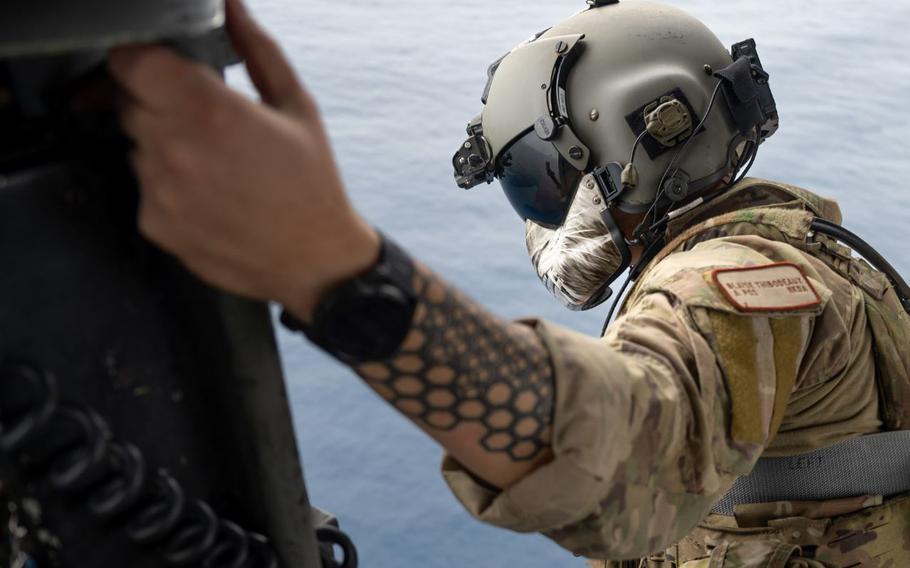Spotlight!
33rd RQS celebrates HH-60G legacy with formation flight
18th Wing Public Affairs April 30, 2024

U.S. Air Force Senior Airman Blaise Thibodeaux, 33rd Rescue Squadron special missions aviator, looks out over the Pacific Ocean during a formation flight off the coast of Okinawa, Japan, April 16, 2024. Special missions aviators perform a multitude of duties including pre-flight inspections, managing weight distribution and placement of passengers and cargo, and coordinating employment of weapons and defensive systems. (Staff Sgt. Jessi Roth, U.S. Air Force)
KADENA AIR BASE, Japan -- Since 1982, the HH-60G Pave Hawk has created a valiant legacy of combat search and rescue, disaster relief, casualty evacuation and medivac for the U.S. Air Force. From the hot and dry deserts of the middle east, to the stormy seas of the pacific, rescue operators have felt assurance in this bird saving people on their worst days.
“The G model is an amazing aircraft, built based on black hawk models and with lessons learned from survivability in Vietnam,” said U.S. Air Force Lt. Col. Louis Nolting, 33rd Rescue Squadron commander. “Predecessors, and other lessons learned, aided in the golf model’s battle damage resilience, automatic flight control systems, weapons systems, hoists and aerial refueling capabilities.”
Throughout the HH-60G Pave Hawk’s career, it’s seen a diverse range of operations to include search and rescue in Operation Desert Storm and Operation Tomodachi, humanitarian relief missions in Africa, recovery operations after Hurricane Katrina and many more missions; always ready so others may live.
“It’s a reliable aircraft in time of need when other aircraft aren’t suited for the job,” said U.S. Air Force Master Sgt. Jeffrey Hegstrom, 33rd RQS special missions aviator. “The Golf has shown time and time again that it’s more than capable for combat search and rescue operations in any environment.”
The HH-60G Pave Hawk has garnered a motivated community of team oriented service members who are passionate in their roles to put these birds in the sky.
“Being responsible for a multi-million dollar aircraft can be daunting,” said U.S. Air Force Staff Sgt. Andrew French, 718th Aircraft Maintenance Squadron flying crew chief. “But to see our operators rescue people and return them to their families is very fulfilling.”
French also expresses satisfaction in his job as a flying crew chief, seeing the Pave Hawks fly off and knowing he and his team are helping accomplish a greater mission.
“Along with the modernized advanced avionics that come with the latest HH-60 Whiskey model, come new challenges that this team is ready to face,” said French.
During this transition, the 33rd RQS will learn how to fly the whiskey model before it’s put in action. The HH-60G Pave Hawk model is expected to be fully divested by the end of the fiscal year, with the whiskey ready to take on the challenges ahead.
“The legacy of the The HH-60G Pave Hawk is nearly unparalleled,” said Nolting. “The thousands of lives rescued, and how it continues to fly day in, day out, is a testament to its operational capability.”